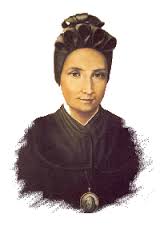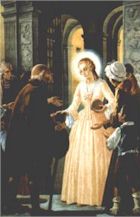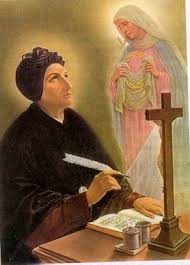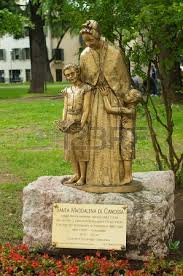
Summary: St Magdalene of Canossa was born in Verona, Italy, on 2 March 1774. At age 15 she announced she wished to become a nun, but after trying out her vocation with the Carmelites, she realised she really wanted to serve the needy without restriction. She began a charitable organisation to help the wounded and the sick, but gave special attention to girls living in poverty and those who had been abandoned.
Patrick Duffy tells her story.
Canossa
This is an historical town near Modena in northern Italy associated with the influential Countess Matilda. It was also the place where the emperor Henry IV submitted to Pope St Gregory VII. But in the last two centuries it has become associated with the Canossian family of Daughters and Sons of Charity founded by St Magdalen of Canossa.
Early life
 St Magdalene of Canossa was born the third of six children of a noble family in Verona, Italy, on 2 March 1774. Her father died when she was five and her mother remarried soon after, so Magdalene was brought up by an uncle and given a good education. At age 15 she announced she wished to become a nun, but after trying out her vocation with the Carmelites, she realised she really wanted to serve the needy without restriction.
St Magdalene of Canossa was born the third of six children of a noble family in Verona, Italy, on 2 March 1774. Her father died when she was five and her mother remarried soon after, so Magdalene was brought up by an uncle and given a good education. At age 15 she announced she wished to become a nun, but after trying out her vocation with the Carmelites, she realised she really wanted to serve the needy without restriction.
Canossa
The name “Canossa” has been connected with the history of Italy since the 11th Century AD when the famous Countess Matilda (1045-1115) exercised a strong political influence for nearly half a century. It was there too that the German Emperor Henry IV submitted to Pope St Gregory VII during the dispute over lay investiture.
Napoleon at Canossa
 Magdalen was 15 years old when the French revolution broke out and shook the whole of Europe. In Verona the real consequences were felt about seven years later, when, on June 10, 1796, General Napoleon entered the city as a conqueror. The following year Napoleon was a guest at Canossa Palace and Magdalen, being the lady of the house, received the General. He returned in 1805 and 1807 as Emperor and was a guest at Canossa Palace. By then Magdalen had already undertaken the work she had long wanted to do.
Magdalen was 15 years old when the French revolution broke out and shook the whole of Europe. In Verona the real consequences were felt about seven years later, when, on June 10, 1796, General Napoleon entered the city as a conqueror. The following year Napoleon was a guest at Canossa Palace and Magdalen, being the lady of the house, received the General. He returned in 1805 and 1807 as Emperor and was a guest at Canossa Palace. By then Magdalen had already undertaken the work she had long wanted to do.
A charitable organisation
Magdalen began a charitable organisation to help the wounded and the sick, but gave special attention to girls living in poverty and those who had been abandoned. Aware of the contrasts between the very rich and very poor, she moved more to care for children, youth and women beset by economic as well as moral, spiritual, intellectual and family poverty.
 Daughters of Charity
Daughters of Charity
In 1808 she left the Canossa Palace indefinitely and with some companions, established herself in a poor district of San Zeno. This small group of women were contemplatives, not of the cloister but on the street. Magdalen called them “Daughters of Charity” because their task was to reveal God’s love to humanity.
Full of missionary spirit
 Magdalen’s vision was full of a missionary spirit and she often said she was prepared to go anywhere and do anything so that Jesus would be known and loved. Although she did not herself fulfil that dream, over time, houses were opened throughout Italy.
Magdalen’s vision was full of a missionary spirit and she often said she was prepared to go anywhere and do anything so that Jesus would be known and loved. Although she did not herself fulfil that dream, over time, houses were opened throughout Italy.
Death 1835
At the time of her death on 10 April 1835, there were five houses of Canossian Sisters. Today the congregation has almost 4,000 members in 395 houses in 35 countries around the world and the “Canossian family” includes the Canossian Sons of Charity (priests and brothers – founded 1821) as well as Canossian lay helpers.
Canonisation
On October 2, 1988 Pope John Paul II canonised St Magdalen of Canossa, a prophet of charity.
____________________________
******************************
Memorable Sayings for Today
Service is what prayer looks like when it gets up off its knees and walks around in the world.”
~ Michael J. Graham, S.J.~
“Memories of our lives,
of our works and our deeds
will continue in others.”
~ Rosa Parks ~
“Each of us has a fire in our hearts for something.
It’s our goal in life to find it and keep it lit.”
~ Mary Lou Retton ~
******************************
”